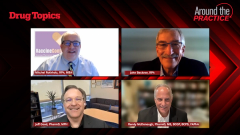
Disparities in Public Access to Vaccines Across Patient Demographics
Key opinion leaders discuss disparities across varying patient demographics concerning access to vaccines.
Episodes in this series

Mitchel Rothholz, RPh, MBA: Let’s talk about some individuals and communities, individuals within racial and ethnic groups or who are from foreign countries. The statistics show that they have lower rates of vaccination against flu and other recommended vaccines. How can pharmacists help in that regard? Who can they partner with to reach some of these hard-to-reach populations?
Randy McDonough, PharmD, MS, BCGP, BCPS, FAPhA: Mitch, I appreciate that question. One thing COVID-19 taught us is that we have some health disparities as far as who’s getting access to vaccines. The other thing we learned is that we didn’t know who those patients were unless we worked with certain stakeholders within the community. It became more of a community-wide response vs a pharmacy response. We’ve learned to work with our local public health department, our social services department, senior citizen centers, and churches to identify individuals who otherwise may have access problems to vaccines.
We’re not only working with those groups but coordinating efforts to get to those groups, whether through remote clinics or even getting to homebound patients. I’m not just a community pharmacy that provides care to the patients who use my pharmacy. I’m a community pharmacy in the true sense that we’re a community-wide responder to patients who don’t even use our practice. We help provide solutions to the community to reach those hard-to-reach patients.
John Beckner, RPh: Randy articulated that very well. One silver lining of COVID-19 has been the relationship that pharmacies have developed with their local health departments. There are certainly some great examples of pharmacy and public health working together, and we hope that collaboration continues well beyond COVID-19 and into the future. That’s very important.
The other thing I wanted to mention is that with some of these populations in underserved areas, there’s a combination of vaccine hesitancy and mistrust coupled with access. I have a good friend who’s an African American pharmacist in inner-city Richmond. We’ve had numerous conversations over the last year. She said, “My patients trust me. I have no problem convincing them that they need to come in and be vaccinated. The problem is having them come in because a lot of them have transportation issues.” To Randy’s point, it’s a community-wide effort to increase confidence and access. It’s across the board, and it takes a village. It isn’t just the pharmacist. It’s the pastors, barbers, and public health. It’s across the board.
Jeff Goad, PharmD, MPH: That’s a great point, John. Randy hit on it earlier when he was talking about those outreach efforts. We leave the pharmacy and go somewhere. Two things have happened that are going to help us close the gap. One is COVID-19 got more pharmacies involved in vaccination than were involved before. Our independents [pharmacies] stepped up in California and across the board. A lot of our [independent pharmacies are in] rural areas. California has some rural areas and some areas that are underserved. We now have pharmacies giving an array of vaccines that they weren’t before. That’s No. 1, and that’s definitely helping us do that.
The second is going out to where they are. If you aren’t where they are, go to where they are. One thing we did very well before COVID-19 was flu outreach. We’d set up at a church, in a parking lot, or at a health fair. We have to get back to that and get other vaccines involved. We now have portable electronic systems. It used to always be that we couldn’t enter the information in the registry because we were in a park. Now Wi-Fi is everywhere. You can get access and get that information in there so we can expand the number of vaccines we could give in all locations. If it isn’t your pharmacy, go to where they are.
Mitchel Rothholz, RPh, MBA: Jeff, that’s a great point. As all 3 of you have mentioned, we’ve got models where that has worked successfully, and models where working with public health has opened some doors for communities. Through COVID-19, we saw the test of the immunization neighborhood. It isn’t just a theory. It could work and benefit communities. That’s the important part of building on that model.
Transcript edited for clarity.
Newsletter
Pharmacy practice is always changing. Stay ahead of the curve with the Drug Topics newsletter and get the latest drug information, industry trends, and patient care tips.
















































































































